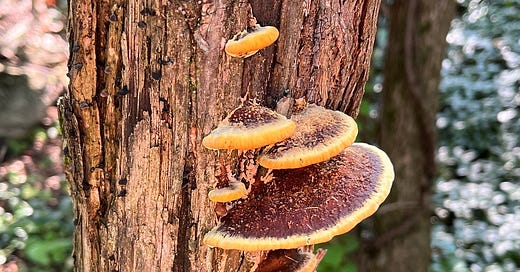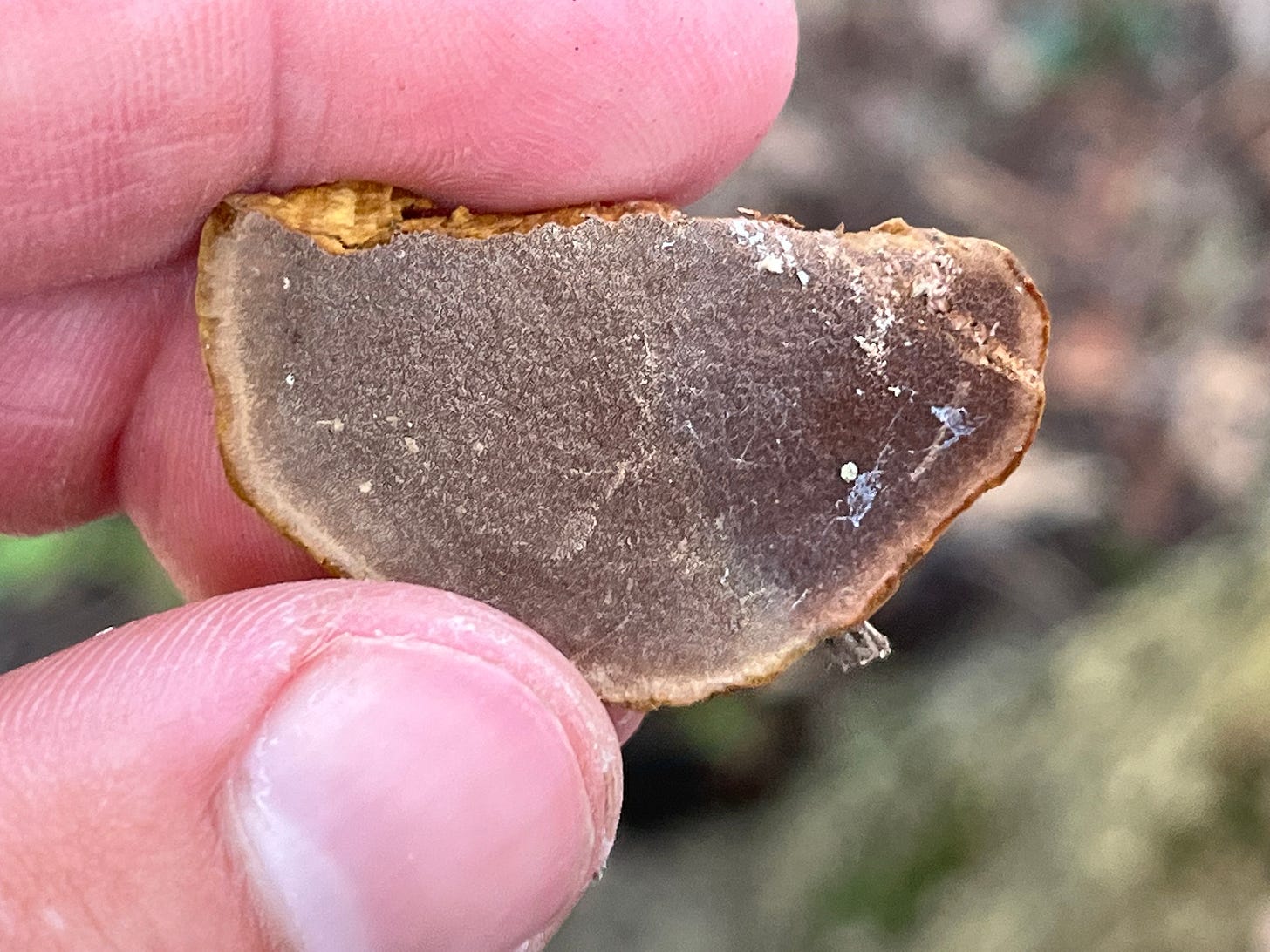Good evening, friends,
We’re back on a Monday to close out the month of July. The walk yesterday was a lot of fun and very fulfilling - definitely a highlight of my time working at Manitou. I’m certainly tuckered out though. Those coolers that’d I left outside for a year didn’t clean themselves and then fill themselves with La Croix and watermelon, I’ll tell ya that much. In all seriousness though the conditions were nearly perfect - certainly the best they’d been all month - as the temperature and humidity dropped, the bugs buzzed off, and the mushrooms were abundant. Enough of the cute stuff though, let’s look at this week’s mushroom: the Mustard Yellow Polypore (Fuscoporia gilva).

Fun Facts
The mushroom used to be known as Phellinus gilvus, before the genus Phellinus was split into several different genera, and had been synonymous with a Chinese medicinal mushroom known as Sanghuang. The taxonomy is pretty tricky to follow - no surprise there - and now there’s a genus Sanghuangporus that consolidates those East Asian medicinal mushrooms. However, there are still studies on the medicinal compounds of Phellinus gilvus, so it looks like our common brown polypore retains a lot of the potent medicinal compounds found in its East Asian sibling. Extracts of the fungus have slowed the growth of melanoma tumors in mice (Reference 4) and have been used traditionally to treat everything from stomach issues to cancer.
Fuscoporia comes from the Latin adjective “fusca” which means dark brown, and the suffix -poria refers to the pore surface. So we get dark brown pore surface. The species epithet Gilva is derived from the Latin Gilvum and means “pale yellow” - the color of fresh mushrooms.
An interesting personal note is that this mushroom fruited last year, but the brackets were very small - the largest maybe two inches across. This year there were several more fruiting bodies and they were much larger - the largest bracket over six inches in width. Perhaps the added moisture this year allowed the fungus to produce more robust mushrooms.
Ecology
The fungus is both saprobic on the dead wood of hardwoods and can also digest the heartwood of living trees (sapwood actively carries water and nutrients, heartwood is more for structural support) . It can be found year-round but fresh fruiting bodies have a mustard yellow margin and lighter pore surface that stains brown when blemished (above). The fungus is fairly common on either side of the Rockies in North America, and further out can be found on every other continent besides Antarctica. The mushrooms grow in the summer but persist year-round, although they fade to brown after a few weeks (below).
Yesterday’s Walk
Thank you again to everyone who showed up - family, friends, and fungophiles alike. We had a great turnout and the species list is almost finished, but there are two species I wanted to highlight. The first is Pluteus atromarginatus, a mushroom that isn’t seen very often in the northeast (just a handful of iNat observations from the area). The distinct feature is the black color on the edge of the gills. You can see it most prominently below on the left.
The other mushroom that stuck with me was Rhodofomes cajanderi, a sweet scented polypore that I was introduced to last summer at the Rochester Area Mycological Association foray in Letchworth State Park. These specimens weren’t too big but the candy smell and vibrant color more than made up for their diminutive stature.

The temporary switch to Toadstool Tuesday the past eight weeks made me realize it’s pretty nice not to transition right from the weekend into spending 4-5 hours crafting a mushroom email, but alas the alliteration with Mushroom and Monday lands just so happens to be the first day of the work week and here we are. Back on track and very excited for what we’ll find at Mycofest this weekend.
Two full moons this month, the first is the “Sturgeon Moon” tomorrow,
Aubrey
References
Kuo, M. (2007, March). Phellinus gilvus. Retrieved from the MushroomExpert.Com Web site: http://www.mushroomexpert.com/phellinus_gilvus.html
Huo J, Zhong S, Du X, Cao Y, Wang W, Sun Y, Tian Y, Zhu J, Chen J, Xuan L, Wu C, Li Y. Whole-genome sequence of Phellinus gilvus (mulberry Sanghuang) reveals its unique medicinal values. J Adv Res. 2020 Apr 28;24:325-335. doi: 10.1016/j.jare.2020.04.011. PMID: 32455007; PMCID: PMC7235939.
https://www.messiah.edu/Oakes/fungi_on_wood/poroid%20fungi/species%20pages/Phellinus%20gilvus.htm
https://www.sciencedirect.com/science/article/abs/pii/S0304383504006226?via%3Dihub









